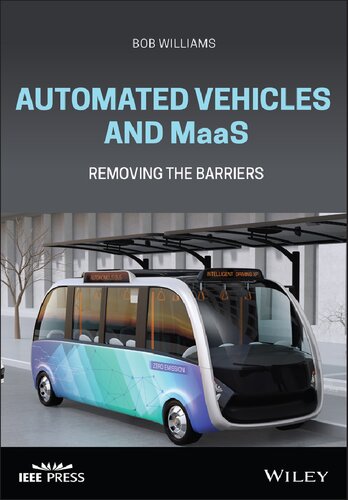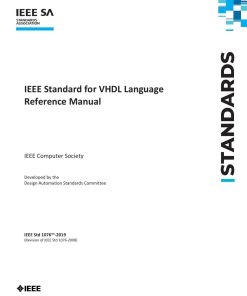Automated Vehicles and MaaS Removing the Barriers 1st Edition by Bob Williams ISBN 111976534X 9781119765349
$50.00 Original price was: $50.00.$25.00Current price is: $25.00.
Automated Vehicles and MaaS Removing the Barriers 1st Edition by Bob Williams – Ebook PDF Instant Download/Delivery: 111976534X, 9781119765349
Instant download Full Chapter of Automated Vehicles and MaaS Removing the Barriers 1st Edition after payment

Product details:
ISBN 10: 9781119765349
ISBN 13: 111976534X
Author: Bob Williams
AUTOMATED VEHICLES AND MaaS
A topical overview of the issues facing automated driving systems and Mobility as a Service, identifies the obstacles to implementation and offers potential solutions
Advances in cooperative and automated vehicle (CAV) technologies, cultural and socio-economic shifts, measures to combat climate change, social pressures to reduce road deaths and injuries, and changing attitudes toward self-driving cars, are creating new and exciting mobility scenarios worldwide. However, many obstacles remain and are compounded by the consequences of COVID-19. Mobility as a Service (MaaS) integrates various forms of public and private transport services into a single on-demand mobility service. Combining trains, cars, buses, bicycles, and other forms of transport, MaaS promises a convenient, cost-effective, and eco-friendly alternative to private automobiles.
Automated Vehicles and MaaS: Removing the Barriers is an up-to-date overview of the contemporary challenges facing CAVs and MaaS. Written in a clear and accessible style, this timely volume summarizes recent research studies, describes the evolution of automated driving systems and MaaS, identifies the barriers to their widespread adoption, and proposes potential solutions to overcome and remove these barriers. The text focuses on the claims, realities, politics, new organizational roles, and implementation problems associated with CAVs and MaaS―providing industry professionals, policymakers, planners, administrators, and investors with a clear understanding of the issues facing the introduction of automated driving systems and MaaS. This important guide and reference:
- Provides an overview of recent progress, the current state of the art, and discussion of future objectives
- Presents both technical background and general overview of automated driving systems and MaaS
- Covers political, commercial, and practical issues, as well as technical and research content, yet suitable for non-specialists
- Helps readers make informed decisions and realistic estimates for implementing mobility solutions and new business models for transport services
- Includes an extensive bibliography with direct links to in-depth technical engineering and research information
Automated Vehicles and MaaS: Removing the Barriers is an essential resource for transport providers, vehicle manufacturers, urban and transport planners, students of transportation, vehicle technology, and urban planning, and transport policy and strategy managers, advisors, and reviewers.
Table of contents:
1.The promise and hype regarding automated driving and MaaS
- The promise
- What do we mean by the term ‘automated driving’?
- The hype
2.Automated Driving levels
- SAE J3016
- The Significance of Operational Design Domain (ODD)
- Deprecated terms
- No relative merit
- Mutually Exclusive Levels
- J3016 Limitations
- Actors in the automated vehicle paradigm
- Other functions
- Regulation data access
3.The current reality
- UNECE WP 29
- Social acceptance
- SMMT
- Other observations
- The European Commission
- Legislation
- Subsidiarity
- Viewpoints
4.Automated Driving Paradigms
- OECD
- Communications evolution
- Cooperative ITS
- The C-ITS Platform
- Holistic approach
- It won’t happen quickly
- Implications of fully automated vehicles
5.The MaaS Paradigm
- Purist definition for MaaS
- Vehicle manufacturer perspective for MaaS
- Traditional transport service provider perspective for MaaS
- MaaS from the perspective of the MaaS Broker
- MaaS as a tool for Social Engineering
- MaaS experience to date
- MaaS and Covid-19
6.Challenges facing automated driving
7.Potential problems hindering the instantiation of MaaS
- Root causes of obstacles
- Level of community readiness
- Level of Social Engineering readiness
- Perception of risks
- Level of market readiness
- Level of Software solution readiness
- Training
- Timing
- Institutional & Governance
8.Potential solutions to overcoming barriers to automated driving
- Vehicle manufacturers flawed paradigm of the automated vehicle
- Vehicle manufacturers using different paradigms for competitive advantage
- Road operator’s responsibilities
- New modes of transport and new mobility services must be safe and secure by design
- How other road users interact with AVs
- Automated vehicles will have to be able to identify and consistently respond to different forms of communication
- AV’s by themselves will not necessarily be smarter than conventional vehicles
- Congestion levels will not drop significantly
- Automated vehicles will release unsatiated demand
- Safety and some operational data must be freely shared
- Mixed AV and conventional traffic
- AV Acceptability
- Low latency communication
- Roads could be allocated exclusively to AVs
- Automated and connected vehicles bring new requirements
- Cybersecurity
- Changing speed limits and even getting signs put up can take years
- Political decisions needed
- Role of government
- Fallback to driver
- Range of services supported
- Young drivers and experience
- Liability
- Level 5 may take a long time to instantiate
9.Potential solutions to overcoming barriers to MaaS
- Addressing General issues
- Essentials to enable MaaS
- Removing Obstacles to MaaS
- Innovative enablers for MaaS
10.The C-ART innovation
- Overview
- Policy context
- Key conclusions
- C-ART scenarios
11.Potential solutions to instantiate AVs and MaaS: Managed Architecture for Transportation Optimisation (MOAT)
- Managed not controlled
- High level Actors in the MOAT architecture
- MOAT from the subscriber / user perspective
- MOAT from the Travel Service Provider perspective
- MOAT from the road operator perspective
- MOAT from the AV operator (AVO) perspective
- MOAT from the Travel Optimisation Service (TOS) perspective
- MOAT from the Traffic Management Centre (TMC) perspective
- MOAT from the Travel Information Provider (TIP) perspective
- MOAT and privacy
- The MOAT overview architecture
- The MOAT systems architecture
12.The Business Case for MaaS
- The Challenge
- The Solution
- The Outlook
13.The Business Case for Automated Vehicles
- The Challenge
- The Solution
- The Outlook
14,Timescales to successful implementation
- Caveat
- Phased MOAT
- Timescales MaaS
- Timescales for Automated Vehicles
- The first half of the Twentieth Century
- The second half of the twentieth Century
- 2000 – 2009
- 2010-2019
- 2020 – 2029
- 2030 – 2039
- 2040 – 2050
- 2050-2060
People also search:
automated vehicle barrier
automatic vehicle barrier system
automated barriers
automatic vehicle barrier
automated vehicle crashes
You may also like…
Uncategorized
Business & Economics - Responsibility and Business Ethics
Algorithms And Autonomy The Ethics Of Automated Decision Systems 1st Edition Alan Rubel
Romance - Fantasy
Engineering - Environmental
Removing Barriers to Environmental Comfort in the Global South Laura Marín-Restrepo
Uncategorized
Fiction - Contemporary Fiction
Mathematics - Wavelets and signal processing
Automated Sound Design 1st Edition by Eric Lyon ISBN 9780895798947 0895798948
Engineering - Electrical & Electronic Engineering
Education Studies & Teaching - Educational Theory
Microwave theory and techniques 1st Edition by IEEE Microwave Theory and Tecnique Society










